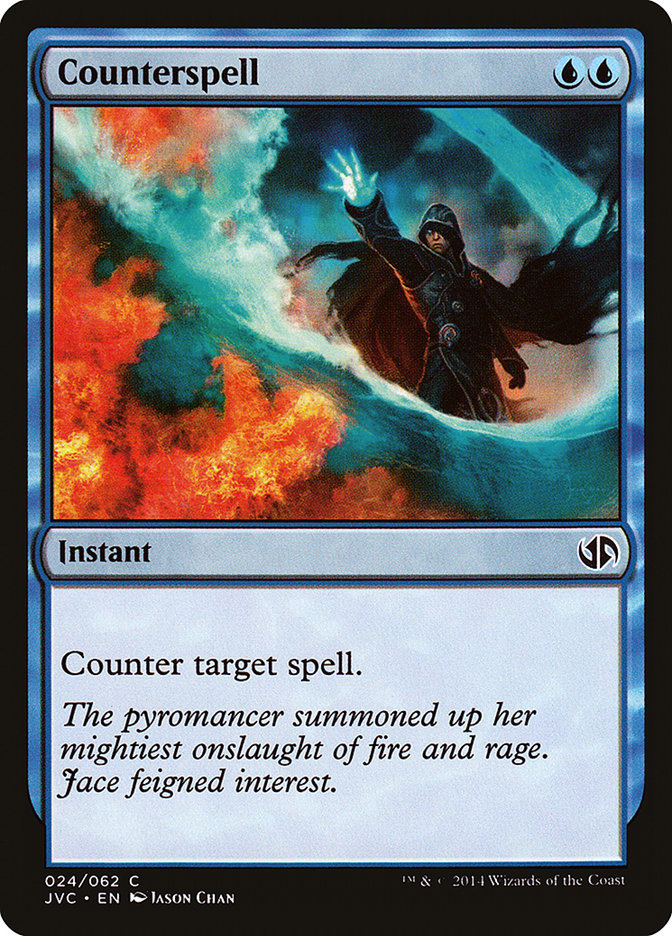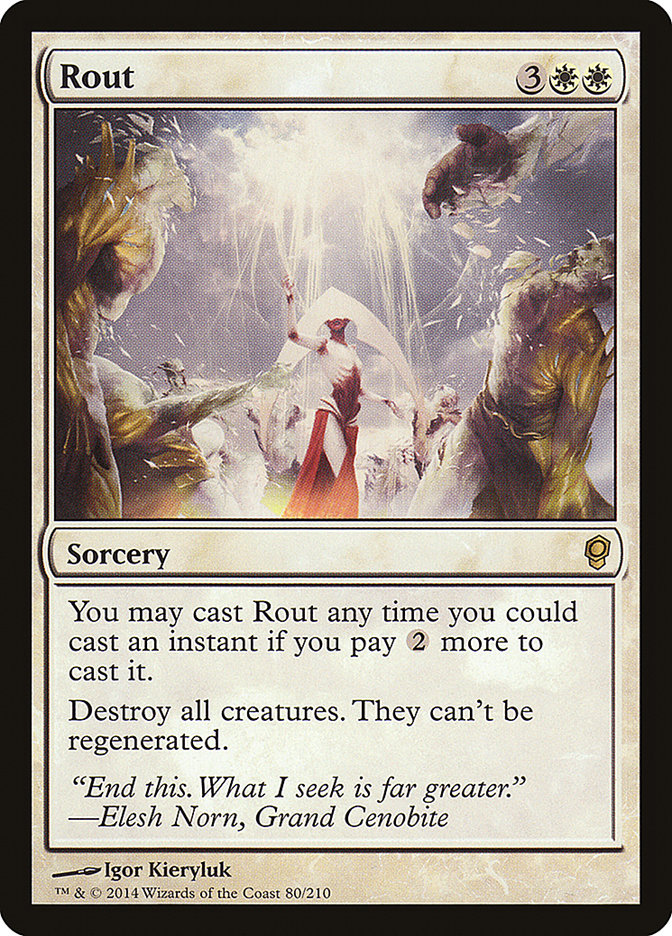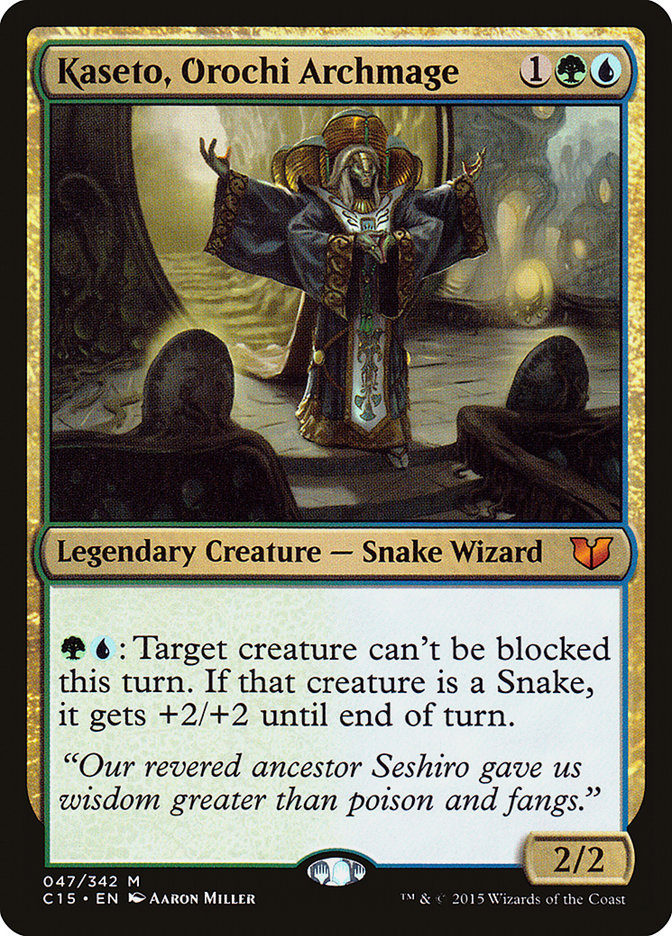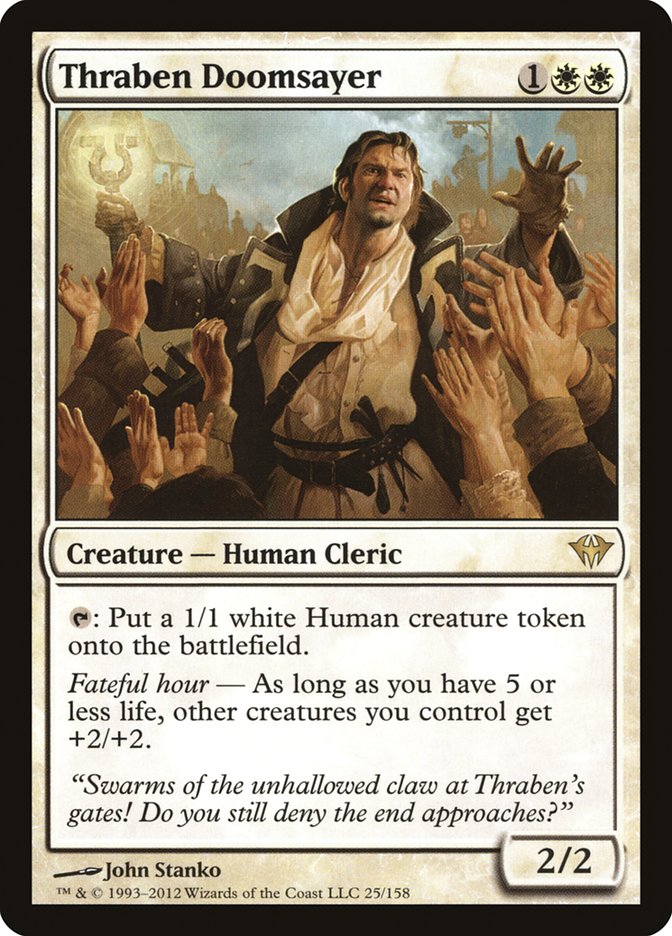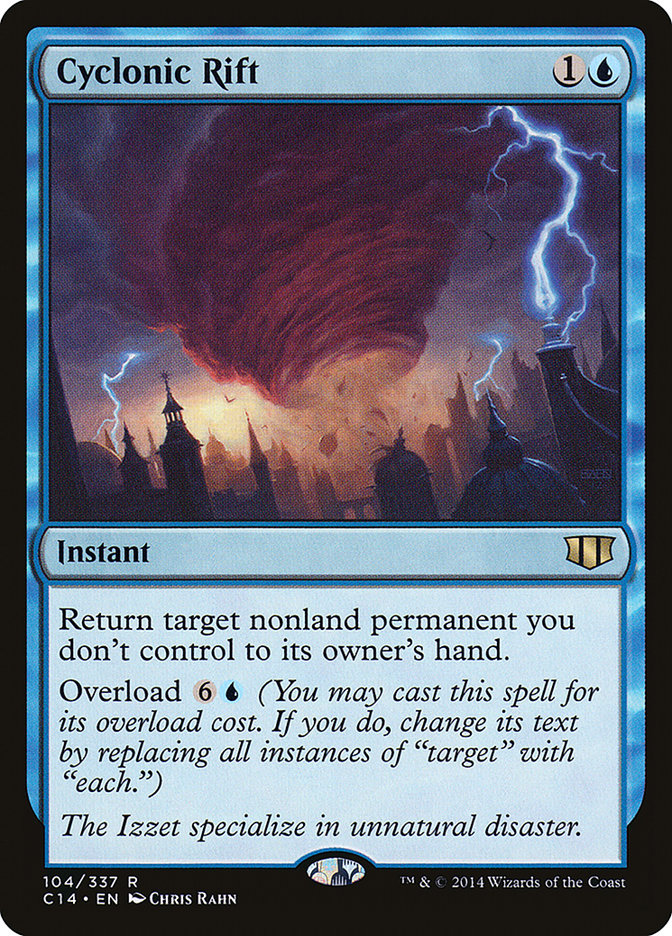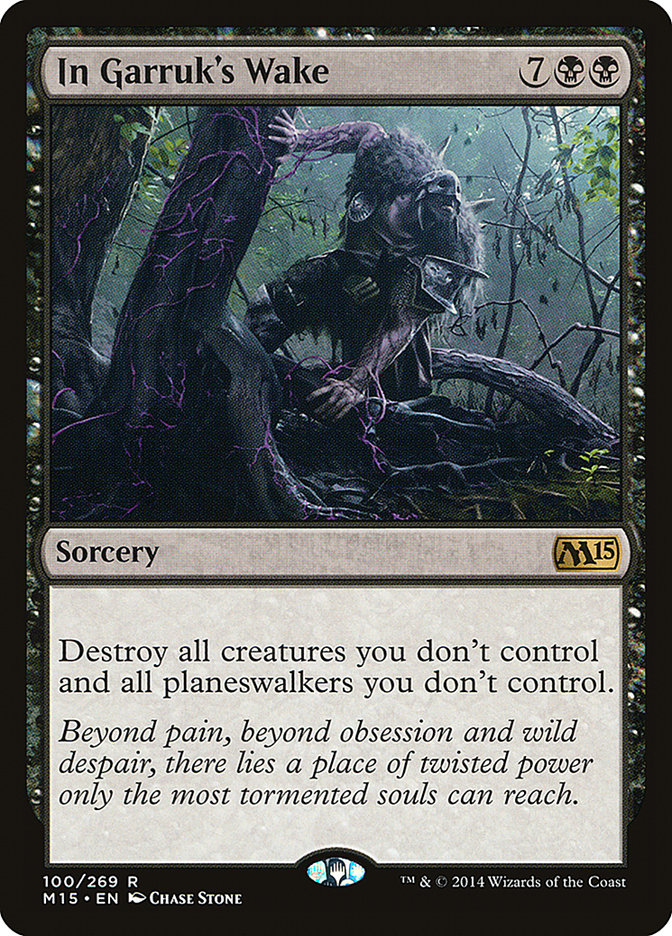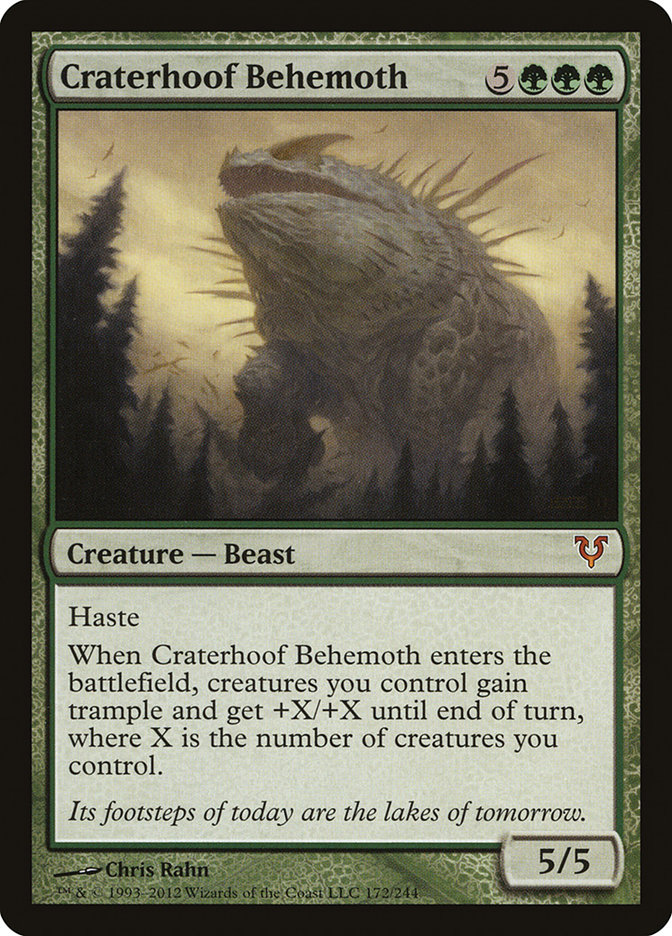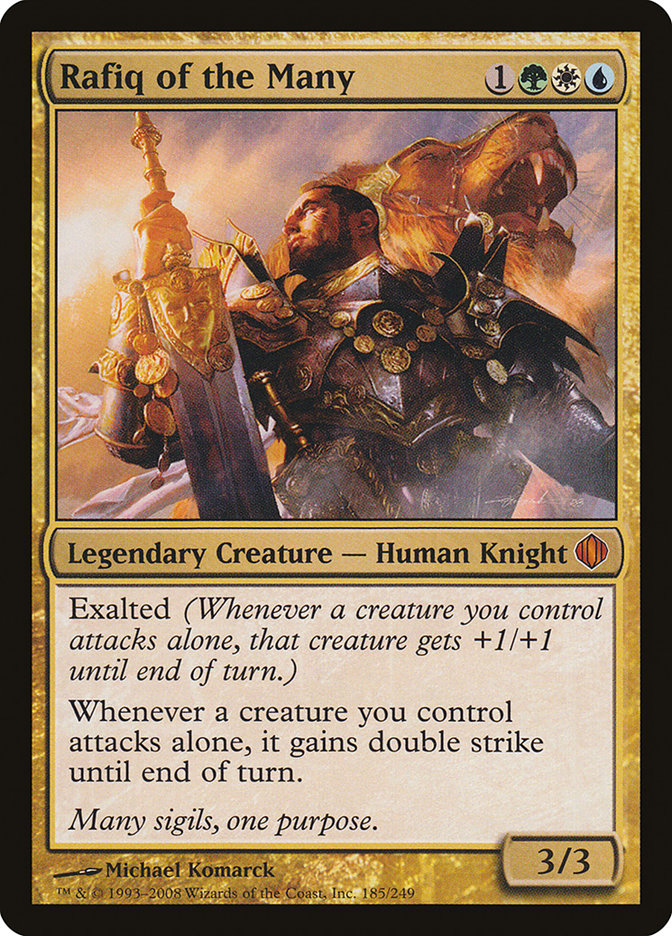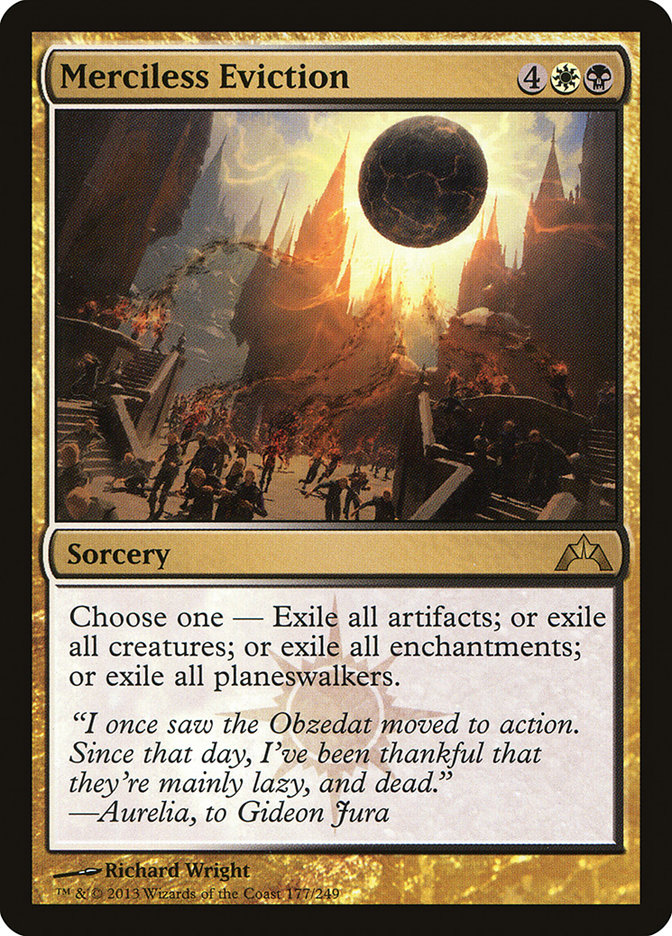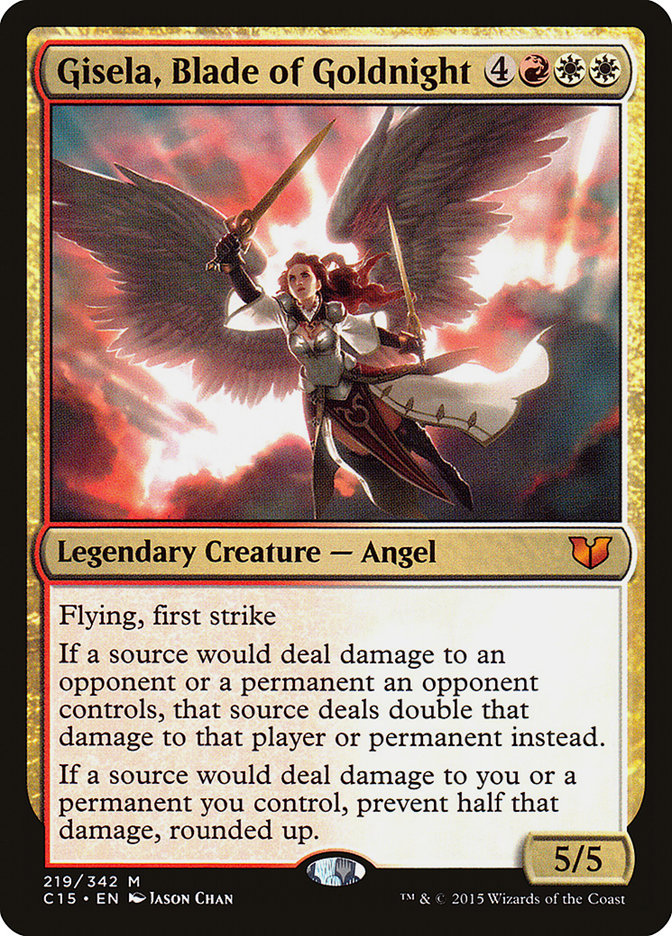Welcome to the third part of the Choosing Decks series. Commander games most often range from three to six players, but what works effectively in these situations varies from size to size. A two-player Commander game is much better off using the Duel Commander or French Commander setup, which has different rules and a different banlist. I’m not familiar with that format enough to offer any advice. However, a game with only three players uses the exact same structure and rules as a game of six players (I really really do not recommend going above six players for Commander). This range of players functions completely differently for each game.
Today I’m focusing on the five-player games: what their pacing is like, how this impacts deck archetypes, variants on the game that I recommend for this size game, and a deck recommendation.
Five-player games for Commander are an absolute beast. No hyperbole, no joke. The number of players that can and will disrupt your plans is staggering. It may not seem like a huge jump in game size from a four-player game, but anyone who has played a five-player game knows the struggle I am talking about. The games are monstrous epic battles where things shift and swing in huge ways as turns pass. While these games are fun, it is a challenge to excel in a five-player game.
Pacing
Let’s break down the most noticeable change from a four-player to five-player game: the time difference. While a four-player game takes more time than a three-player game, the change is typically into a more relaxed pace. This relaxed pace doesn’t carry into a five-player game in the same way. Rather, the pace becomes much more cumbersome.
It takes longer for each player’s turn to come around. This can increase the chance of a player checking email or playing on their phone another way. Then the player stops listening to the game and need to be shaken to get back to reality when the turn passes. Please do not be this person!
The time increases for game reasons too, mostly due to answers. The game’s natural pace takes longer with the increased decision trees and increased chances of someone not directly involved in a combat or spell interfering with Counterspell, Fog, Path to Exile, or an instant-speed Rout. This just naturally consumes more time. But the biggest slowdown I encounter is battlefield wipes.
The game is chugging along when Player One casts a Descend upon the Sinful. All the creatures get exiled, so Player Two and Player Three recast their commanders. Player Four generates a whole bunch of tokens with Secure the Wastes and a Parallel Lives. Player Five sees this and then plays another sweeper like Blasphemous Act and recasts her general. What happened this round? Nothing!
The increase of sweepers and answers puts a huge damper on the chance of a player to snowball out of control. This does help keep really powerful decks in check (five-player games can handle a variety of deck power levels because of the number of answers present), but every time the battlefield is reset back to square one, the clock keeps ticking but nothing actually happens in the game.
Sharks to Blood
As most people know in five-player games, they typically take longer and players cannot hover at low life totals. Collateral damage will happen, and it will remove a player who is clinging to life and needs to take a turn. In a five-player game, burn spells like Earthquake and Molten Disaster are much better as they hit more players. If someone is low enough that a small to medium Earthquake will take them out, the player casting Earthquake will almost certainly make sure it drops the opponent.
Collateral damage also comes from Magic players’ desire to get value. A Kaseto, Orochi Archmage deck will slide a critter past all the blockers and remove a player. Someone with a Coastal Piracy will attack just for the trigger and incidentally knock out a player. Be prepared: the Fateful Hour mechanic is not your friend.
Kingmaker
Another circumstance more common in five-player games is being placed into a kingmaker role. Once a player is eliminated in a five-player game, there is blood in the water. Many times this means that the next weakest player is shortly eliminated too.
But what happens to the three sharks with no minnows in the pond? They circle and wait. In this circumstance, any remaining player can remove either opponent left in the game, but not both at the same time. Each player knows that taking out any single player will result in them losing, so a long, long jockeying for position happens. Hopefully this is quickly resolved with a haymaker like Insurrection or Cyclonic Rift, but if not, the sharks keep swimming and building to the battlefield.
My suggestion? Take a moment and look around the room, shop, or convention center for an SCG Tour® side event. If the two eliminated players are waiting on a game and you have a haymaker, then go for it. If the two eliminated players are in a game, keep playing for the win and take your time.
If the two eliminated players are waiting and you have no haymaker, it may be time to go a little bit into table talk. Ask if anyone has a way to break the stalemate. If no one does, you need to decide what you prioritize. Eliminating someone and losing means the next game starts up soon and everyone is back in the fun. Going for the win can be amazing or grueling and it depends on the decks and your group; you will know what is more likely to happen. I just suggest for you to decide if a long grinding game is what you want or if it is better to play the kingmaker role and decide that someone other than you is winning the game.
Deck Choices
As my other articles on game size have explained, the basic archetypes of aggro, control, and combo change effectiveness with game size. The change from four to five players hurts aggressive decks. More players means more life and the 40 starting life is already a hurdle. By five players, the aggressive decks are leaning more and more to Voltron strategies or using huge plays like Craterhoof Behemoth to take out several opponents.
However, even infamous Voltron generals like Rafiq of the Many; Atarka, World Render; and Skullbriar, the Walking Grave can be overcome with removal spells. In a game this large, I recommend either a heavy token strategy to overwhelm opponents or a dedicated Voltron strategy. Even though there is more removal to deal with, a commander like Atarka, World Render can still carry the day. If Plan A is double-striking Dragons and Plan B is regular Dragons, things are still looking pretty good when the plan changes.
As always, combo decks work well. Combo is a strategy that always works and gets better with more players. If you are in a competitive group, have a blast. But if people want a slugfest, a dedicated storm combo deck using Mind’s Desire or Tendrils of Agony is not really the deck to bring out.
Control decks have to change plans in a five-player game. Counterspells can work (and really still do) but how a counter is used must change. Stopping a threat is good, but protecting your gameplan is usually the correct move. Battlefield control becomes more favorable and prison-style decks pick up a lot of steam as they punish more players. A deck like Numot, the Devastator that is loaded with Wildfire and Armageddon effects can clean up the table regardless of how many players are left if the deck is firing on all cylinders.
However, even the best use of control effects can still go awry. Countering a game-winning Tooth and Nail is a good move, but doing so doesn’t stop the next opponent from plopping down an Insurrection and winning that combat phase.
The haymakers make battlefield control more attractive, and despite my warnings about the pacing, you should play some. Getting blown out because someone else had their gameplan up and running before you did is not very fun. Resetting them with a Merciless Eviction can help achieve parity or put you in the lead.
Not Always Free-for-All
With the shifts and changes to the game’s pace and focus, some variants are sure to appear for a given format. I have tried several five-player formats over the years, but many work best outside Commander games. That isn’t helpful for you, so I present the following format variants: Star and Bang!/Kingdoms.
Star is a very straightforward format. Five players sit in a circle (or at a rectangular table with three on one side and two on the other; or two and two with the fifth at the short edge of a table) and correspond to the five orbs on the back of a Magic card. You do not need to play decks of any specific color, but feel free to add that restriction in your own playgroup; it’s fun. The player in the white seat is allies with the players in the blue and green seats. The white player’s enemies are the players in the black and red seats. If the white player’s enemies are eliminated first, the white player wins. A player cannot attack allies, but targeted spells like Doom Blade, Naturalize, or Lightning Bolt can hit anyone or any legal target on the battlefield. All global effects like Wrath of God affect everyone’s battlefield.
The game is faster because only two or three people are eliminated when the game ends. Also, the dynamics are different when your blue ally is protecting your black enemy because they both need to eliminate your green ally or you’ll win the game when the black player dies. Try the format out and see what you think. I do recommend you cut back a little on the sweepers just a bit so that the game progresses well.
Another variant is Kingdoms Commander. This is a spin on the game “Bang!” for Commander games (note: there are a variety of ways to play this variant and I’m presenting just one). In Kingdoms there are five roles: King, Knight, Bandit, Usurper, and Assassin. Each player is given a role secretly and cannot reveal their role until they lose; this includes any “politics” and bribes for information. The game plays as a normal free-for-all but each role modifies how a player can win.
King: The King goes first and start the game at 50 life (you can also give the king an extra card and maximum hand size; my group doesn’t). To win, be the last player standing or have only the King and Knight remain in the game. If the King kills the Knight, the King loses half his or her life and sacrifices half of his or her permanents.
Knight: Be the last player remaining player with the King.
Bandit: Eliminate the king. The Bandit does not need to deliver the killing blow.
Usurper: Deal the killing blow to the King. Rather than eliminating the King, the Usurper becomes King and goes to 50 life while the former King is now the Usurper at one life (this does not impact the battlefield, graveyard, exile, command zone, or cards in hand). All loyalties and enemies now shift with changing of the King.
Assassin: Be the last player standing.
This game is ridiculous and extremely fun. It works well for changing things up and adding an unknown element to the gameplay. There are no known allies in this game. The strategies change for each role and winning is more difficult than many realize. However, this variant will give you crazy stories. For example, a Knight trying to throw off the others attacks the King for two damage. The King immediately focus-fires the Knight for two or three turns and eliminates him. The whole table freaks out as the King killed his only ally by turn 6. The King did not win that game. What stories can you create with this format?
Deck Choice
Almost any deck choice can work for the variants, and with Kingdoms particularly it is difficult to say what type of deck is best. But for a free-for-all five-player game, I prefer a deck that can hit multiple opponents at one time. Closing out a game quickly is important and the combat phase alone is often not enough. That can be big X-spells like Earthquake and Molten Disaster or a huge group of tokens getting triggers from Purphoros, God of the Forge; you just have to be building to something.
In these games, I like a deck that can go wide with tokens to help swarm around blockers and (more importantly) present blockers. A cluster of 1/1 tokens won’t do much in combat, but they make an opponent go elsewhere for a more profitable attack or keep giant scary creatures like Ulamog, the Ceaseless Hunger or Kozilek, the Great Distortion from hitting your life total. Losing chunks of life in ten or more is still threatening with 40 life to start with.
Creatures (17)
- 1 Sakura-Tribe Elder
- 1 Wood Elves
- 1 Yavimaya Elder
- 1 Autochthon Wurm
- 1 Taurean Mauler
- 1 Farhaven Elf
- 1 Frontier Guide
- 1 Ogre Battledriver
- 1 Purphoros, God of the Forge
- 1 Gahiji, Honored One
- 1 Scourge of the Throne
- 1 Soul of Theros
- 1 Reclamation Sage
- 1 Jazal Goldmane
- 1 Sunscorch Regent
- 1 Managorger Hydra
- 1 Greenwarden of Murasa
Lands (41)
Spells (41)
- 1 Exploration
- 1 Swords to Plowshares
- 1 Sol Ring
- 1 Fecundity
- 1 Kodama's Reach
- 1 Fires of Yavimaya
- 1 Moment's Peace
- 1 Mirari's Wake
- 1 Sword of Fire and Ice
- 1 Skullclamp
- 1 Lightning Greaves
- 1 Explosive Vegetation
- 1 Rith's Charm
- 1 Hull Breach
- 1 Skyshroud Claim
- 1 Aura Shards
- 1 Doubling Season
- 1 Glare of Subdual
- 1 Krosan Grip
- 1 Return to Dust
- 1 Akroma's Memorial
- 1 Rites of Flourishing
- 1 Oblivion Ring
- 1 Naya Charm
- 1 Beastmaster Ascension
- 1 Eldrazi Monument
- 1 Cultivate
- 1 Overwhelming Stampede
- 1 Swiftfoot Boots
- 1 Warstorm Surge
- 1 Parallel Lives
- 1 Hammer of Purphoros
- 1 Commander's Sphere
- 1 Song of the Dryads
- 1 Shamanic Revelation
- 1 Berserkers' Onslaught
- 1 Impact Tremors
- 1 Nissa's Pilgrimage
- 1 Zendikar's Roil
- 1 Retreat to Emeria
- 1 Blade of Selves

Critical Pieces and Game Plan
Hazezon Tamar is a fun commander that makes tokens…eventually. The delayed trigger is frustrating compared to newer token commanders, but the deck is very fun to play. With tokens comes some of the usual token fare like Doubling Season and Parallel Lives. There are some really good token makers like Parallel Evolution and its counterpart Second Harvest (I don’t own one yet). Then I like some pump effects to make the 1/1 Sand Warrior tokens matter more, so Beastmaster Ascension, Berserkers’ Onslaught, and Overwhelming Stampede. The last critical pieces are ramp spells. Hazezon Tamar needs lands to work, so I play a lot of ramp to get those lands out and Hazezon on the battlefield.
My favorite card is Blade of Selves equipping Hazezon Tamar himself. The Sand Warrior tokens are bound to Hazezon, so him leaving the battlefield will exile them all. Blade of Selves provides a workaround and a lot of tokens. The myriad trigger makes several copies of Hazezon, which have their own enters-the-battlefield triggers for tokens. The legend rule lets you sacrifice all but one copy of Hazezon; make sure you sacrifice the original since you want all copies to go away. Next upkeep, you get X 1/1 Sand Warrior tokens, where X is the number of lands you control, for each opponent! Even without Purphoros, God of the Forge, you have a lot of potential damage and there are haste enablers to fight the good fight!
Creatures (13)
- 1 Heartless Hidetsugu
- 1 Solemn Simulacrum
- 1 Taurean Mauler
- 1 Magma Phoenix
- 1 Silverchase Fox
- 1 Angel of Serenity
- 1 Boros Reckoner
- 1 Blaze Commando
- 1 Burnished Hart
- 1 Nyx-Fleece Ram
- 1 Sunscorch Regent
- 1 Sandstone Oracle
- 1 Endbringer
Planeswalkers (3)
Lands (38)
- 8 Plains
- 1 Boseiju, Who Shelters All
- 10 Mountain
- 1 Smoldering Crater
- 1 Shinka, the Bloodsoaked Keep
- 1 Eiganjo Castle
- 1 Temple of the False God
- 1 Secluded Steppe
- 1 Forgotten Cave
- 1 Tower of the Magistrate
- 1 Battlefield Forge
- 1 Boros Garrison
- 1 Sacred Foundry
- 1 Terramorphic Expanse
- 1 New Benalia
- 1 Ancient Amphitheater
- 1 Tectonic Edge
- 1 Evolving Wilds
- 1 Command Tower
- 1 Boros Guildgate
- 1 Wind-Scarred Crag
- 1 Needle Spires
Spells (45)
- 1 Fireball
- 1 Sol Ring
- 1 Earthquake
- 1 Inferno
- 1 Fellwar Stone
- 1 Rolling Thunder
- 1 Darksteel Ingot
- 1 Mirari
- 1 Starstorm
- 1 Akroma's Vengeance
- 1 Loxodon Warhammer
- 1 Mind Stone
- 1 Invulnerability
- 1 Gossamer Chains
- 1 Orim's Thunder
- 1 Rout
- 1 Ghitu Fire
- 1 Breath of Darigaaz
- 1 Boros Signet
- 1 Condemn
- 1 Return to Dust
- 1 Austere Command
- 1 Prison Term
- 1 Goblin Assault
- 1 Vicious Shadows
- 1 Relic of Progenitus
- 1 Martial Coup
- 1 Seer's Sundial
- 1 Dreamstone Hedron
- 1 Into the Core
- 1 Staff of Nin
- 1 Assemble the Legion
- 1 Wear
- 1 Boros Cluestone
- 1 Deflecting Palm
- 1 Goblinslide
- 1 Commander's Sphere
- 1 Chandra's Ignition
- 1 Pyromancer's Goggles
- 1 Hedron Archive
- 1 Stasis Snare
- 1 Retreat to Emeria
- 1 Fiery Confluence
- 1 Thought Vessel
- 1 Seer's Lantern

Critical Pieces and Game Plan
Gisela, Blade of Goldnight just wants to wreck people with burn spells.
The big X-spells Molten Disaster and Rolling Thunder are the best, but smaller burn spells like Fiery Confluence and Breath of Darigaaz are incredible with Gisela doubling the damage output. To power out a seven-mana general in poor ramp colors, there is a need for lots and lots of artifact ramp. Sol Ring, Commander’s Sphere, Mind Stone, Hedron Archive, Dreamstone Hedron, and more help get to the boatloads of mana. Then battlefield control spells help buy more time to get Gisela online. Finally it’s on to the game winners like Earthquake and Heartless Hidetsugu. The most fun cards are Pyromancer’s Goggles and Mirari to copy the burn spells and take out the table twice as quickly.
Wrap-Up
Five-player games take a while, so I prefer haymakers and other power plays to keep the whole table on a clock. Both Hazezon and Gisela have ways to pressure opponents outside of combat, and in a five-player game you will often need more than just combat phases to win games. It is always important to play a deck you enjoy, I like going big compared to grinding out games with this many players, but if incremental advantage is your thing, have fun with it! Commander games need more giggles, so play what you love after getting the table on the same page.
What strategies do you find work for a five-player Commander game? Ever try out Star or Kingdoms? Let me know in the comments below or the Twitterverse.


